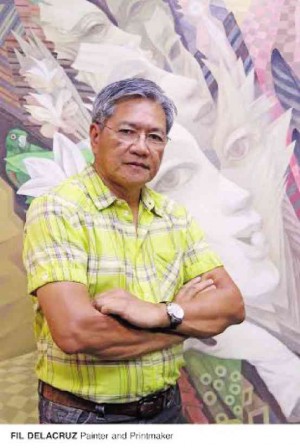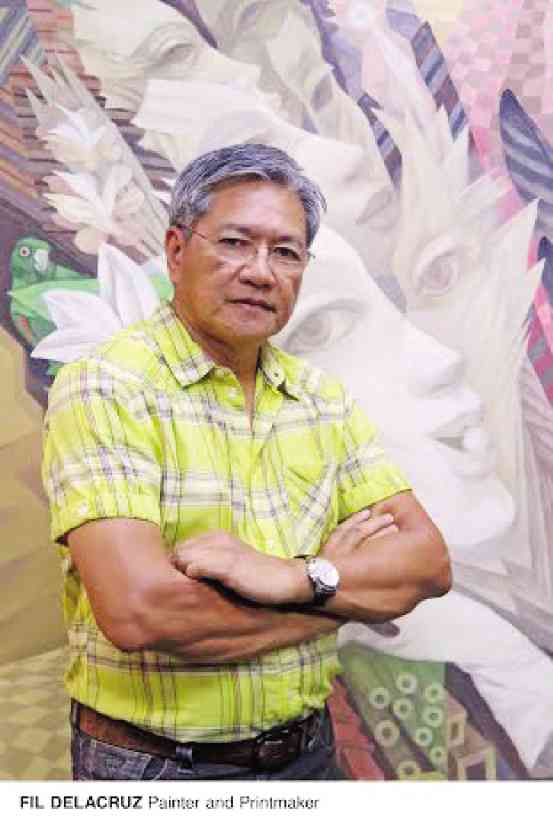FIL DELACRUZ, among a very select few of Filipino artists who could be said to have mastered both painting and print, has just turned 65, and it is only fitting that the milestone be marked with a miniretrospective of his works, particularly of his “Diwata” series since the 1980s.
“Para/phrase” is being held at the gallery of the National Commission for Culture and the Arts in Intramuros, and the choice of venue could not have been more appropriate. The exhibit after all focuses on the series that art lovers most identify Delacruz with—the “Diwata” series inspired by Gunsal Malayo, the young woman from the B’laan tribe in Sultan Kudarat in the late ’70s and ’80s, in whom the artist found not only ethereal beauty and charm, but also a powerful embodiment of the cosmology of the indigenous Filipino.
The series has seen a number of incarnations and transformations through the decades, incorporating, for example, certain notions of Christian dualism (good and evil, light and darkness), as well as contemporary discourses on technology, globalization and the environment.
Despite its intellectual sophistication, the series would not have engaged the collective imagination if not for Delacruz’s very original and compelling iconography and composition. From Mindanao to Intramuros, from the tumultuous last quarter of the 20th century to the new century, “Diwata” in its many metamorphoses represents the history of the Philippines.
‘Heresy of paraphrase’
It seems at first blush unfortunate for the artist and his curators to have chosen “Para/phrase” as a title. As the artistic notes say, the title refers to “a restatement of the meaning or passage using other words.” The addition of the slash is not only redundant, it is also awkward since it manifests today’s illiterate practice especially among young Filipinos of using the punctuation as a substitute for “and/or.”
The title likewise misses the point about the artistic integrity of the series. It seems to say that the new works are restatements of previous series. It therefore commits what Cleanth Brooks in the context of literature famously calls the “heresy of paraphrase.”
From New Criticism in literature studies, one learns that one can’t really paraphrase the meaning of a fictional, poetic and/or dramatic piece. Meaning especially in poetry is irreducible because, as Brooks explains, “a true poem is … an experience rather than any mere statement of … any mere abstraction from experience.” American poet Archibald MacLeish puts it more memorably: “A poem should not mean / But be.”
We should recall here that Brooks intriguingly cites painting and the other arts to deny that literature has any summarizable content: “The essential structure of a poem (as distinguished from the rational or logical structure of the ‘statement’ which we abstract from it) resembles that of architecture or painting: It is a pattern of resolved stresses.”
Although New Criticism and critical formalism have had their day, their emphasis on the organic unity of the literary work and rejection of critical dualism between form and content remain valid aesthetics with which to approach any work, literary or nonliterary.
Private and public
To be sure, New Critical close reading has assumed “uber” or excessive proportions through “deconstruction” and the reality-denying or meaning-decentering overkill of much of postmodernism. But its emphasis on the linguistic elements of a literary work, regardless of genre or typology, remains a wise guide to the appreciation and evaluation of an artwork.
In the case of the “Diwata” series and its permutations across the decades, they should be seen as attempts to form a pattern of “resolved stresses” or, adopting Brooks’ further comparison of poetry with the temporal arts such as music and ballet, as “resolutions and balances and harmonizations, developed through a temporal scheme.”

Part of our intense fascination with the “Diwata” series is its romantic, biographical moorings. Its gestation owes to the young Fil Delacruz’s odyssey in Mindanao in the late 1970’s and the next decade amid the depredation and repression of martial law. Its stylistic and iconographic evolution may be said to be a visual roman à clef, a fictionalized biography or a Sterneian sentimental journey, a travelogue that is both personal and public.
To be sure, “Diwata” has had a long development that continues up to now: From the initial romantic idealization largely in the artist’s vintage mezzotint of Gunsal Malayo and her physical attributes typical of painters and their models or muses, the series has evolved into the black-and-white lithographs of the 1990s with luxuriant but intriguing details such as masks, the flora and fauna of Mindanao, and mystical eyes. When transposed to oil-on-canvas, the iconography predictably becomes richer and, of course, more colorful.
Modernist legacy
Trained at the University of Santo Tomas, the cradle of modernism in the Philippines, Delacruz engages discursively and stylistically with the modernist legacy of Filipino artists like him. In “Diwata,” Cubist “deconstruction” has been reinvented and even rebuffed but reconstituted correctly as a metaphor for dualism.
Kandinsky’s stimmung, the essential spirit of nature that seems to have been overwhelmed by materialism and technology, is likewise given full rein. The geometric interplay of images in “Diwata” appears to reflect Kandinsky’s acute-triangled “life of the spirit.”

But Delacruz goes beyond his modernist heritage. He restores and remakes classicism, endowing the “Diwata” with the aura of the Madonna (in other works, the Madonna and Child is referenced and recast).
Most important perhaps, he makes the Lumad faery the author of consciousness. Perhaps reflecting Kandinsky’s life of the spirit, the forehead of the woman is wedged and triangled from which springs consciousness and spirit. “Diwata” becomes diwa, intuition becomes consciousness, and nature becomes cosmology.
Daughter of memory
In the universe of the spirit, life-and-death becomes spurious dualism. In the “Diwata” series on “Thanopsis,” for example, death and end become resurrection and exaltation.
“Thanopsis” is probably portmanteau for thanatos or death and apokalypsis or end. In Delacruz’s “Diwata” cosmology, however, apocalypse also means apotheosis, a universal jubilee, a rising to a higher order.
For guiding the “Diwata” through its many metamorphoses, Delacruz has provided us something both intellectually stimulating and aesthetically rewarding. He has provided us a veritable cosmology to the extent that “Diwata” is not anymore Delacruz’s muse; she has become the nation’s as well.

We use the word “muse” here in its restored original sense—as a daughter of memory. Conveniently forgotten in today’s romantic notion of art and inspiration is that the muse is not supposed really to inspire but to remember, to preserve and conserve. That is why one of the nine muses is Clio, the muse of history.
Is there a muse for the visual arts? None.
In Greek mythology, the nine muses were daughters of Mnemosyne from Zeus. They revealed to Hesiod the theogeny or genealogy of the gods. In short, as goddesses of the arts, the muses were supposed to be historians and memorialists of creation and the universe.
In short, art is memory and history. And it is to the credit of Fil Delacruz’s “Diwata” that he has restored the original meaning of the muse not as any self-serving conception of the self-absorbed artist but as the faery, daemon or goddess that propels history and animates its dynamics.
“Diwata” therefore is not a paraphrase; it is not a pseudostatement or restatement. It is history meant not only to be remembered, but also to be experienced and creatively imagined. “Diwata” is the crucible of Philippine history.













































